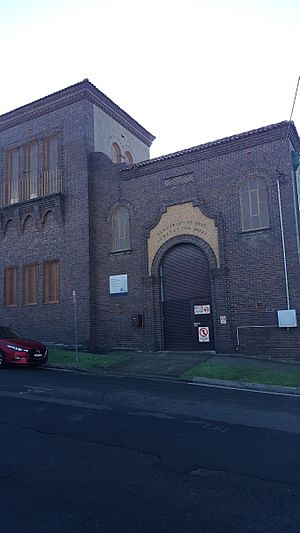Electricity Substation No. 341 facts for kids
Quick facts for kids Electricity Substation No. 341 |
|
|---|---|
 |
|
| Location | 60 Bundock Lane, Randwick, City of Randwick, New South Wales, Australia |
| Built | 1929 |
| Architectural style(s) | Interwar Mediterranean |
| Owner | Ausgrid |
| Official name: Substation; #341 Randwick 33Kv Zone; Canberra Street substation | |
| Type | State heritage (built) |
| Designated | 2 April 1999 |
| Reference no. | 935 |
| Type | Electricity Transformer/Substation |
| Category | Utilities - Electricity |
| Lua error in Module:Location_map at line 420: attempt to index field 'wikibase' (a nil value). | |
The Electricity Substation No. 341 is a special old building in Randwick, Australia. It's located at 60 Bundock Lane. This building was constructed in 1929 and helps supply electricity to the area. It is also known as #341 Randwick 33Kv Zone or Canberra Street substation. The substation is owned by Ausgrid, which is a government agency in New South Wales. Because of its history and design, it was added to the New South Wales State Heritage Register on 2 April 1999.
Contents
History of Randwick Substation
Early History of the Land
Before the 1780s, Aboriginal people lived in this area. They used the land for fishing and important cultural activities. You can still find signs of their presence, like rock carvings and special grinding grooves. In 1789, Governor Arthur Phillip mentioned "a long bay," which we now know as Long Bay.
Aboriginal people have lived in the Sydney region for at least 20,000 years. The Cadigal people lived south of Port Jackson towards Botany Bay. The local clan in the Maroubra area was called "Muru-ora-dial."
How Randwick Grew
One of the first land grants in this area was given to Captain Francis Marsh in 1824. He received 12 acres of land. Later, in 1839, William Newcombe bought land nearby.
The name Randwick comes from a town in England called Randwick, Gloucestershire. Simeon Pearce and his brother James suggested the name. Simeon was born in that English town. He and his brother were very important in developing Randwick and its neighbour, Coogee. Simeon arrived in Australia in 1841 as a surveyor. He built his home, Blenheim House, on land he bought from Marsh and named his property "Randwick."
Simeon worked hard to get a road built from Sydney to Coogee, which happened in 1853. He also pushed for Randwick to become its own local government area. In 1857, the first St Jude's church was built.
In its early days, Randwick was quite isolated. It was surrounded by swamps and sandhills. Travel to Sydney was difficult, and buses often got stuck in the sand. Randwick also had different types of people living there. Wealthy families lived in large, fancy houses. But many working-class people lived in smaller homes, working in market gardens or piggeries.
In 1858, the NSW Government passed a law allowing towns to form their own councils. Randwick was the first to apply and became a municipality in February 1859.
Randwick was also a place for sports. In 1863, John Tait started the Randwick Racecourse. This racecourse changed Randwick a lot. Trams soon connected the suburb to Sydney, making travel much easier. Randwick quickly became a busy and successful place. Today, it is still a lively area with homes, businesses, and the nearby University of NSW and Prince of Wales Hospital.
Electricity for Randwick
The Randwick substation was specially designed and built in 1930. The land for the substation was bought in 1929. This substation was a very important part of the electricity network from the Bunnerong Power Station. It supplied power to all the smaller substations in the Randwick area. The building was finished in 1930. It was built in two halves because it was important to get one half ready before the other.
What the Substation Looks Like
The Randwick substation is a large and attractive building. It has a detailed front that faces the street. Its design is in the Interwar Mediterranean style.
The front of the building has two main parts. One part is two storeys tall. It has a tall entrance door with special arch patterns. There are also three sets of triple windows. Some windows have arches, and one set has a small balcony with decorative railings.
The second part of the front is balanced on both sides. It has a large arched doorway. This doorway is framed by flat, decorative columns called pilasters. Above the doorway are arched windows and a fancy panel with the building's name. The top edges of the roof, called parapets, have curved roof tiles.
The substation is built with strong brick walls. The windows seem to be made of metal with many small glass panes. The large doors for equipment are steel roller shutters. The building is in good condition.
Why it's a Heritage Site
The Randwick substation is a rare and important building. It is very attractive and shows off the Interwar Mediterranean style well. Even though it was a major part of the electricity network, the Sydney Municipal Council wanted it to be a beautiful building. They wanted it to fit in with the residential area around it.
The Electricity Substation No. 341 was officially listed on the New South Wales State Heritage Register on 2 April 1999.

